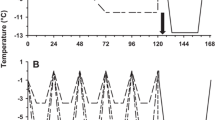Summary
Wall lizards were collected in the fall of 1988 from a population introduced in 1951 into Cincinnati, OH. They were acclimated to 5 °C for several weeks prior to testing at sub-zero temperatures. Eleven super-cooled lizards were removed from the cooling chamber prior to crystallization after between 15 min and 26 h at body temperatures ranging from -2.2 to -5.9 °C. With the exception of one individual supercooled to-5.0 °C, all lizards recovered fully. The crystallization temperatures of 15 lizards which froze ranged from -0.6 to -6.4 °C. Frozen lizards were stiff with a distinct blue color, which faded upon thawing at 3 °C. The ice contents of frozen lizards were determined calorimetrically and/or estimated from a theoretical model, the two methods being generally in close agreement. Remarkably, five individuals recovered fully from exposures as long as 2 h and with as much as 28% of their body water frozen. Although these animals are not as tolerant as certain other vertebrates they are clearly able to withstand freezing under some circumstances. Failure to survive freezing was attributed either to excessive ice accumulation during a prolonged freeze or to excessive supercooling prior to freezing, which induced a large initial surge of ice formation upon crystallization. Our results accord with those of Weigmann (1929). We accordingly recognize him as the first to demonstrate freeze-tolerance in vertebrates, and we further recognize P. muralis as the first vertebrate known to survive freezing.
Similar content being viewed by others
References
Cameron AT, Brownlee TI (1913) The effect of low temperature on the frog. Trans R Soc Can 7:107–124
Claussen DL, Costanzo JP (1990) A simple model for estimating the ice content of freezing ectotherms. J Thermal Biol (In Press)
Costanzo JP (1988) Recovery from ice-entombment in garter snakes. Herp Rev 19:76–77
Costanzo JP, Claussen DL (1990) Natural freeze tolerance in the terrestrial turtle, Terrapene carolina. J Exp Zool (In Press)
Costanzo JP, Claussen DL, Lee RE Jr (1988) Natural freeze-tolerance in a reptile. Cryo-Lett 9:380–385
Hedeen SE (1984) The establishment of Podarcis muralis in Cincinnati, Ohio. Herp Rev 15:70–71
Knauthe K (1891) Methe Erfahrungen über das Verhalten von Amphibien und Fischen gegenüber der Kälte. Zoolog Anz 14:104–106
Kodis T (1898) Die Unterkühlung der tierischen und pflanzlichen Gewebe. Zbl Physiol 12:593–595
Layne JR, Jr, Lee RE Jr (1987) Freeze-tolerance and the dynamics of ice formation in wood frogs (Rana sylvatica) from southern Ohio. Can J Zool 65:2062–2065
Layne JR, Jr, Lee RE Jr (1989) Seasonal variation in freeze-tolerance and ice content of the tree frog Hyla versicolor. J Exp Zool 249:133–137
Lee RE Jr, Lewis E (1985) Effects of temperature and duration of exposure on tissue ice formation in the gall fly, Eurosta solidaginis (Diptera, Tephritidae). Cryo-Lett 6:25–34
Lotshaw DP (1977) Temperature adaptation and effects of thermal acclimation in Rana sylvatica and Rana catesbeiana. Comp Biochem Physiol 56A:287–294
Lowe CH, Lardner PJ, Halpern EA (1971) Supercooling in reptiles and other vertebrates. Comp Biochem Physiol 39A:125–135
MacArthur DL, Dandy JWT (1982) Physiological aspects of overwintering in the boreal chorus frog (Pseudacris triseriata maculata). Comp Biochem Physiol 72A:137–141
Müller-Erzbach W (1891) Die Widerstandsfähigkeit des Frosches gegen das Einfrieren. Zoolog Anz 14:383–384
Musacchia XJ, Sievers ML (1956) Effects of induced cold torpor on blood of Chrysemys picta. Am J Physiol 187:99–102
Packard GC, Packard MJ, McDaniel PL, McDaniel LL (1989) Tolerance of hatchling painted turtles to subzero temperatures. Can J Zool 67:828–830
Paukstis GL, Shuman RD, Janzen FJ (1989) Supercooling and freeze-tolerance in hatchling painted turtles (Chrysemys picta). Can J Zool 67:1082–1084
Réaumur (de) RA (1737) Des chenilles qui vivent en société. In: Mortier P (ed) Mémoires pour servir à l'histoire des Insectes. Vol 2. Amsterdam, pp 153–225. cited in Vannier G (1986) Accroissement de la capacite de surfusion chez les adultes de Chrysoperla carnea (Insectes Nevropteres) entrant en diapause hivernale. Neuroptera Internat 4:71–82
Schmid WD (1982) Survival of frogs in low temperature. Science 215:697–698
Spellerberg IF (1972) Temperature tolerances of southeast Australian reptiles examined in relation to reptile thermoregulatory behaviour and distribution. Oecologia 9:23–46
Spellerberg IF (1976) Adaptations of reptiles to cold. In: d'A Bellairs A, Cox CB (ed) Morphology and biology of reptiles. Linnacean Soc Symp, Series 3, pp 261–285
Storey KB (1984) Freeze-tolerance in the frog, Rana sylvatica. Experientia 40:1261–1262
Storey KB (1985) Freeze-tolerance in terrestrial frogs. Cryo-Lett 6:115–134
Storey KB, Storey JM (1988) Freeze-tolerance in animals. Physiol Rev 68:27–84
Storey KB, Storey JM, Brooks SPJ, Churchill TA, Brooks RJ (1988) Hatchling turtles survive freezing during winter hibernation. Proc Natl Acad Sci 85:8350–8354
Street D (1979) The reptiles of northern and central Europe. B.T. Batsford Ltd, London
Weigmann R (1929) Die Wirkung starker Abkühlung auf Amphibien und Reptilien. Z Wiss Zool 134:641–692
Author information
Authors and Affiliations
Rights and permissions
About this article
Cite this article
Claussen, D.L., Townsley, M.D. & Bausch, R.G. Supercooling and freeze-tolerance in the European wall lizard, Podarcis muralis, with a revisional history of the discovery of freeze-tolerance in vertebrates. J Comp Physiol B 160, 137–143 (1990). https://doi.org/10.1007/BF00300945
Accepted:
Issue Date:
DOI: https://doi.org/10.1007/BF00300945




